From the introduction of the Richard Henry Lee resolution on 7 June 1776 (1) to Congress’s final publication on 18 January 1777 of an attested, printed Goddard version (9) printed while the Congress was in exile in Baltimore, the Declaration kept developing and changing shape. When the Lee resolution for independence lacked support from at least 5 colonies, a committee of 5 was appointed to develop a document. The drafting committee (2), with Jefferson as primary drafter, developed a Declaration justifying the resolution for independence. It presented its final draft (3) to the Congress on 28 June 1776. Congress deliberated from 2-4 July 1776 and incorporated its changes in the Dunlap broadside (4). On 5 July 1776 copies were sent by express to George Washington and provincial assemblies and major committees of correspondence for reprinting in the newspapers and by broadside (6). The Declaration was proclaimed before Washington’s regiments (9 July 1776) and in public meetings throughout the colonies (7). On 10 July 1776, the New York Convention supported independence; on 19 July Congress ordered an engrossed copy of the Declaration (8) for signing by members of Congress. After its retreat from Philadelphia (to Baltimore) the Congress voted to have the signed Declaration printed by Mary Katherine Goddard (9), attested by the President and Secretary of the Congress, and distributed to the thirteen states. Through its arc of development the title, speaker, and material shapes of Declaration reflected both the successful reception of the Declaration as well as Congress’ effort to increase the authority of its declaration of independence from Britain.
|
1. Lee Resolution: placed before Congress on June 7, 1776.
“That these United Colonies are, and of right ought to be, free and independent States, that they are absolved from all allegiance to the British Crown, and that all political connection between them and the State of Great Britain is, and ought to be, totally dissolved.”
|
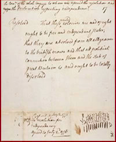 |
2. The Drafting Committee:
The committee of 5 -- Thomas Jefferson, John Adams, Benjamin Franklin, Roger Sherman, Robert R. Livingston--meets to determine the main heads of the argument. The Jefferson first draft, which only exists in fragments, incorporated at least 47 alterations before becoming the final committee draft (See 3) Some of the changes are written in the hand of John Adams and Franklin Benjamin Franklin. The draft was referred to Congress on 28 June.
Notable change in title: From “Declaration of the representatives” to “Declaration by the representatives” |
|
3. Final Committee Draft:
A Declaration by the Representatives of the UNITED STATES OF AMERICA, in General Congress assembled. Jefferson later made copies of his rough draft for Richard Henry Lee, George Wythe, and James Madison, and included a version in his 1821 unpublished Autobiography.
|
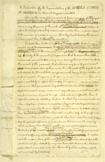 |
4. What is done in Congress:
During the deliberation in Congress, meeting as a committee of the whole on 2-4 July 1776, the committee draft received 39 more alterations, many of them significant, including drastic cuts that reduced the length of the Declaration by one quarter. |
 |
5. Dunlap Broadside:
With notable change in title:
In Congress, July 4, 1776. A Declaration
By the Representatives of the United States of America
In General Congress Assembled.
|
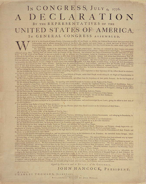 |
6. Dissemination of the Declaration in Newspapers and Broadsides: newspapers throughout British America and Britain reprint the Declaration in Congress of July 4, 1776.
|
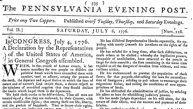
|
7. The Declaration Proclaimed:
9 July 1776: the NY Convention favors Independence
& pulls down the equestrian statue of George III
18 July 1776: Boston hears the Declaration proclaimed before the Town-House |
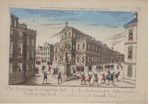
|
8. Engrossed Copy of 2 August 1776:
In Congress, July 4, 1776
The Unanimous Declaration of the thirteen United States of America
|
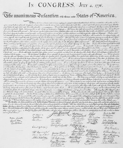 |
9. Goddard Broadside:
In CONGRESS, July 4, 1776
The Unanimous
DECLARATION
Of the
Thirteen United States of AMERICA.
Baltimore, 18 January 1777
“In CONGRESS January 18, 1777. ORDERED. That an authenticated Copy of the DECLARATION of INDEPENDENCY, with the names of the MEMBERS of CONGRESS, subscribing the same, be sent to each of the UNITED STATES, and that they be desired be put on RECORD.” |

|
|

![Protocols of Liberty: Communication, Innovation, and teh American Revolution [Book Banner from Title Page Image]](Images/William_Warner/Protocols_of_Liberty_Illustrations/Protocols of Liberty - Title Banner.png)








